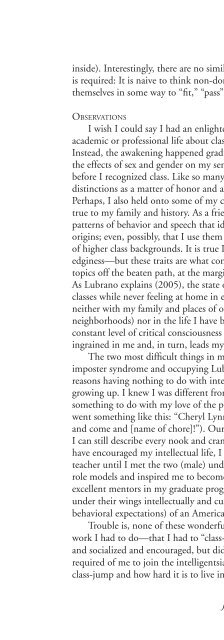WINTER 2012 - National Association of Schools of Public Affairs and ...
WINTER 2012 - National Association of Schools of Public Affairs and ...
WINTER 2012 - National Association of Schools of Public Affairs and ...
Create successful ePaper yourself
Turn your PDF publications into a flip-book with our unique Google optimized e-Paper software.
Amy E. Smith <strong>and</strong> Ignacio J. Martinez-Moyano<br />
<strong>and</strong> underst<strong>and</strong>ing, <strong>and</strong> student-centric considerations (bold in Figure 2). Each<br />
<strong>of</strong> the four macro categories are linked to several clusters <strong>of</strong> ideas, to the seven<br />
pieces <strong>of</strong> advice just discussed, <strong>and</strong> to more than one <strong>of</strong> the challenges associated<br />
with teaching statistics.<br />
Figure 2 also shows how each <strong>of</strong> the macro categories <strong>of</strong> clusters <strong>of</strong> ideas<br />
addresses more than one <strong>of</strong> the four challenges. So, for example, clusters <strong>of</strong> ideas<br />
generated by participants related to the macro category use <strong>of</strong> relevant real-life<br />
applications were generated as ways to address challenge 1, challenge 2, challenge<br />
3, <strong>and</strong> challenge 4. In the same spirit, clusters <strong>of</strong> ideas in the focus on process<br />
<strong>and</strong> underst<strong>and</strong>ing macro category were generated as ways to address challenge<br />
1, challenge 3, <strong>and</strong> challenge 4. This suggests two things. First, that certain<br />
tools <strong>and</strong> techniques may be important for addressing more than one challenge.<br />
Second, if certain tools <strong>and</strong> techniques may be important for addressing<br />
more than one challenge, it is also likely that these four challenges are not<br />
independent, but rather intertwined. Therefore, identifying a specific challenge<br />
in teaching statistics to students enrolled in practitioner-oriented master’s degree<br />
programs <strong>and</strong> the particular tools that will address that specific challenge may<br />
not be the most effective approach. Rather, identifying the system <strong>of</strong> challenges<br />
<strong>and</strong> how the challenges are related to one another may be a useful way to think<br />
about overcoming these challenges <strong>and</strong>, consequently, improving statistical skills<br />
<strong>of</strong> students.<br />
IMPLICATIONS FOR A MODEL OF RESEARCH PRODUCTION AND RESEARCH USE<br />
This study focused on one piece <strong>of</strong> the right-h<strong>and</strong> side <strong>of</strong> our original model<br />
<strong>of</strong> research production <strong>and</strong> research use (see Figure 1), specifically, practitioner<br />
quantitative (statistical) skills to underst<strong>and</strong> <strong>and</strong> use research findings. Because<br />
the findings from the data collection exercise indicated that the four primary<br />
challenges associated with teaching statistics in practitioner-oriented master’s<br />
degree programs are intertwined rather than independent <strong>of</strong> one another, we<br />
integrated the theoretical foundations <strong>of</strong> the study <strong>and</strong> literature with the<br />
preliminary interviews to exp<strong>and</strong> this portion <strong>of</strong> the model. By examining the<br />
collection <strong>of</strong> insights from these sources, we have exp<strong>and</strong>ed the segment <strong>of</strong><br />
our model that focuses on practitioner quantitative skills. Figure 3 depicts this<br />
exp<strong>and</strong>ed model.<br />
The revised version <strong>of</strong> this model describes how the four challenges<br />
associated with teaching statistics to students enrolled in practitioner-oriented<br />
master’s degree programs (in italics in Figure 3) are part <strong>of</strong> a larger system that<br />
links the production <strong>of</strong> research to the consumption <strong>of</strong> research. While each<br />
<strong>of</strong> these challenges influence practitioner quantitative skills to underst<strong>and</strong> <strong>and</strong><br />
use research findings either directly or indirectly, this model underscores the<br />
hypothesized links between the challenges as well. For example, the quantitative<br />
underpreparedness <strong>of</strong> students increases student anxiety about statistics; decreases<br />
126 Journal <strong>of</strong> <strong>Public</strong> <strong>Affairs</strong> Education

















